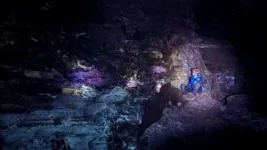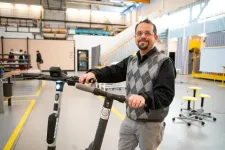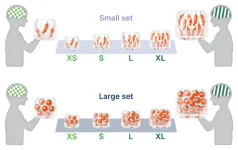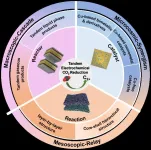(Press-News.org) A new published study reveals plants, fungi, bacteria, protists, and even some viruses deploy venom-like mechanisms, similar to that of venomous snakes, scorpions and spiders, according to researchers at Loma Linda University School of Medicine.
The definition of venom is a biological toxin introduced into the internal milieu of another organism through a delivery mechanism such as a sting or bite that inflicts a wound. According to lead author William K. Hayes, PhD, professor of biology for the Department of Earth and Biological Sciences at the School of Medicine, the findings show that reliance on venom for solving problems like predation, defense, and competition is far more widespread than previously recognized.
“Venomous animals have long fascinated biologists that were seeking to understand their deadly secretions and the traits associated with their use, but have also contributed numerous life-saving therapeutics,” Hayes said. “Until now, our understanding of venom, venom delivery systems, and venomous organisms has been based entirely on animals, which represents only a tiny fraction of the organisms from which we could search for meaningful tools and cures.”
According to the study, It’s a Small World After All: The Remarkable but Overlooked Diversity of Venomous Organisms, with Candidates Among Plants, Fungi, Protists, Bacteria, and Viruses, plants inject toxins into animals through spines, thorns, and stinging hairs, and some also co-exist with stinging ants by providing living spaces and food in exchange for protection. Even bacteria and viruses have evolved mechanisms, like secretion systems or contractile injection systems, to introduce toxins into their targets through host cells and wounds.
Hayes has a long history of researching venom in rattlesnakes, and began exploring a broader definition of venom over a decade ago while teaching special courses on the biology of venom. As he and his team were working on a paper to define what venom truly is, they found themselves encountering non-animal examples and decided to dig deeper to identify numerous examples that may have been overlooked.
This new study paves the way for new discoveries, and Hayes hopes it will encourage collaboration among specialists and scientists across disciplines to further explore how venom has evolved across diverse organisms.
“We’ve only scratched the surface in understanding the evolutionary pathways of venom divergence, which include gene duplication, co-option of existing genes, and natural selection,” said Hayes.
END
New research reveals venomous findings in non-animals
Animals share much in common with other life forms regarding their reliance on toxic secretions to solve critical problems such as predation, defense, and competition
2025-03-25
ELSE PRESS RELEASES FROM THIS DATE:
Ecosystem disrupted following the disappearance of Great white sharks, new study finds
2025-03-25
Ecosystem disrupted following the disappearance of Great white sharks, new study finds
Known for their powerful ability to launch out of the water in pursuit of prey, the loss of Great white sharks from False Bay in South Africa has scientists and conservationists concerned about the rippling effects on the ecosystem.
Miami, Florida – A new study published in the journal Frontiers in Marine Science, has uncovered evidence of far-reaching ecosystem consequences following the disappearance of Great white sharks (Carcharodon carcharias) from False Bay, South Africa. The research, conducted by scientists at the University of Miami Rosenstiel ...
New geometric design of material provides safer bicycle helmet
2025-03-25
By using new geometric shapes in the shock-absorbing material, researchers at the Universities of Gothenburg and Isfahan have developed a bicycle helmet that provides better protection against head injuries. The material absorbs shock by contracting bilaterally.
Bicycle helmets are important for protecting cyclists from head injuries, but traditional designs have limitations in terms of impact absorption and fit. Researchers at the University of Gothenburg and the University of Isfahan in Iran designed a bicycle helmet whose shock-absorbing ...
Why does one person develop schizophrenia while another does not? A leading psychiatric geneticist investigates the answer
2025-03-25
HOUSTON, Texas, USA, 25 March 2025 – Schizophrenia affects millions worldwide, yet its causes remain one of the greatest medical mysteries. In an exclusive Genomic Press Interview, Dr. Consuelo Walss-Bass, a pioneering researcher in psychiatric genetics, shares how both genetic predisposition and environmental factors contribute to severe mental health disorders. As the John S. Dunn Foundation Distinguished Chair in Psychiatry at UTHealth Houston, Dr. Walss-Bass has dedicated her career to understanding these mechanisms, transforming scientific discoveries into real-world applications ...
First joint oscillation analysis of super-kamiokande atmospheric and T2K accelerator neutrino data
2025-03-25
The Super-Kamiokande and T2K Collaborations present a joint measurement of neutrino oscillation parameters from their atmospheric and beam neutrino data. It uses a common interaction model for events overlapping in neutrino energy and correlated detector systematic uncertainties between the two datasets, which are found to be compatible. Using 3244.4 days of atmospheric data and a beam exposure of 19.7(16.3) x 1020 protons on target in (anti)neutrino mode, the analysis finds a 1.9???? exclusion ...
E-scooter crashes mainly caused by reckless driving
2025-03-25
Crashes on electric scooters are mostly due to the behaviour of the riders, with one-handed steering and riding in a group being some of the largest risk factors. The researchers are also concerned about riders who deliberately crash or cause dangerous situations when riding, a phenomenon that seems to be specific to electric scooters. This is shown by a study from Chalmers University of Technology in Sweden, which for the first time examines the causes behind crashes with electric scooters from naturalistic data within an urban environment.
The arrival of electric scooters in cities has meant an opportunity to quickly and smoothly make shorter trips. But not ...
Uncovering the brain’s flexible mechanisms for representing diverse numbers
2025-03-25
Abstract
The National Institute of Information and Communications Technology (NICT, President: TOKUDA Hideyuki, Ph.D.) has revealed, through fMRI-based brain activity analysis, that multiple regions in the human cerebral cortex flexibly represent numerical quantity. This finding comes from research by HAYASHI Masamichi (Researcher (Tenure-Track)) at Center for Information and Neural Networks (CiNet), part of NICT’s Advanced ICT Research Institute, in collaboration with the University of Tokyo’s graduate student KIDO Teruaki (NICT ...
Biological pathway in the brain could help explain why teenage girls are more depressed than boys
2025-03-25
Depression is a mental health condition that affects 280 million people worldwide. It is twice as common in women than men and this pattern starts to develop during adolescence. Researchers have studied the biological processes that drive depression in adults and shown a potential role for the kynurenine pathway, but this is the first time it has been investigated in adolescents in relation to biological sex.
The study was published in Biological Psychiatry and funded by MQ Mental Health Research and supported by the National Institute for Health and Care Research (NIHR) Maudsley Biomedical Research Centre (BRC).
The ‘kynurenine ...
Artisanal fishers are almost as accurate as satellites in producing environmental data
2025-03-25
Artisanal fishers can be almost as accurate as satellite data when it comes to their awareness of features that can be found in the marine environment, a new study has shown.
Published in the journal Ocean and Coastal Management, the research set out to establish the value of local ecological knowledge (LEK) and its ability to generate high quality habitat maps around five Greek islands in the eastern Aegean Sea.
Ten fishermen, based on their individual experience and knowledge, were asked to pinpoint areas where they believed seagrass beds could be found along the coastlines of their respective islands.
The maps they produced were then compared ...
Teaching kids about bugs benefits the environment
2025-03-25
Pro-environmental behaviour increases among school students who participate in insect-related citizen science projects, according to new research from the University of Adelaide.
Students who participated in citizen science project Insect Investigators, which engages students in the discovery of new insects, not only expressed an intention to change their personal behaviour but also to encourage others to protect nature.
“As a result of their involvement in this program, students expressed intentions to further engage in insect–science–nature activities,” says the University of Adelaide’s Dr Erinn Fagan-Jeffries, who contributed ...
Tandem design on electrocatalysts and reactors for electrochemical CO2 reduction
2025-03-25
Electrochemical CO2 reduction (ECR) driven by green electricity represents a promising strategy for CO2 mitigation and utilization by producing fuels and chemicals. Tandem strategy based on multifunctional tandem catalysts or cascade reactors enables deep CO2 reduction to high-value multi-carbon products. Nevertheless, it is challenging to precisely regulate the multi-step reaction pathways toward efficient CO2 conversion. A comprehensive understanding of the tandem reaction mechanisms is crucial for guiding the rational design of advanced catalysts and reactor systems to address these challenges.
This review systematically ...
LAST 30 PRESS RELEASES:
New expert guidance urges caution before surgery for patients with treatment-resistant constipation
Solar hydrogen can now be produced efficiently without the scarce metal platinum
Sleeping in on weekends may help boost teens’ mental health
Study: Teens use cellphones for an hour a day at school
After more than two years of war, Palestinian children are hungry, denied education and “like the living dead”
The untold story of life with Prader-Willi syndrome - according to the siblings who live it
How the parasite that ‘gave up sex’ found more hosts – and why its victory won’t last
When is it time to jump? The boiling frog problem of AI use in physics education
Twitter data reveals partisan divide in understanding why pollen season's getting worse
AI is quick but risky for updating old software
Revolutionizing biosecurity: new multi-omics framework to transform invasive species management
From ancient herb to modern medicine: new review unveils the multi-targeted healing potential of Borago officinalis
Building a global scientific community: Biological Diversity Journal announces dual recruitment of Editorial Board and Youth Editorial Board members
Microbes that break down antibiotics help protect ecosystems under drug pollution
Smart biochar that remembers pollutants offers a new way to clean water and recycle biomass
Rice genes matter more than domestication in shaping plant microbiomes
Ticking time bomb: Some farmers report as many as 70 tick encounters over a 6-month period
Turning garden and crop waste into plastics
Scientists discover ‘platypus galaxies’ in the early universe
Seeing thyroid cancer in a new light: when AI meets label-free imaging in the operating room
Neutrophil-to-lymphocyte ratio may aid risk stratification in depressive disorder
2026 Seismological Society of America Annual Meeting
AI-powered ECG analysis offers promising path for early detection of chronic obstructive pulmonary disease, says Mount Sinai researchers
GIMM uncovers flaws in lab-grown heart cells and paves the way for improved treatments
Cracking the evolutionary code of sleep
Medications could help the aging brain cope with surgery, memory impairment
Back pain linked to worse sleep years later in men over 65, according to study
CDC urges ‘shared decision-making’ on some childhood vaccines; many unclear about what that means
New research finds that an ‘equal treatment’ approach to economic opportunity advertising can backfire
Researchers create shape-shifting, self-navigating microparticles
[Press-News.org] New research reveals venomous findings in non-animalsAnimals share much in common with other life forms regarding their reliance on toxic secretions to solve critical problems such as predation, defense, and competition











